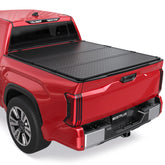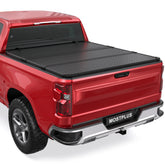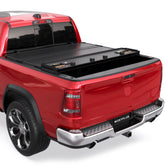How to change brake fluid?
Brake fluid is essential to the operation of your vehicle: it's what allows you to brake. When you depress the brake pedal, the pressure is transferred directly to the wheels. This allows you to slow down each time you apply the brakes.
The heat generated by friction during braking will, over time, change the quality of the brake fluid or cause it to evaporate. This prevents your brakes from working properly.
When your brake fluid has lost its properties, it can affect various vehicle parts and their performance. Brake fluid also acts as a lubricant, preventing all moving brake parts from seizing and rusting. If you notice that your brake fluid is losing its properties, it's time to change it.
When to change brake fluid?
When you brake, the friction between the pads and the rotors generates heat. This repetitive heat (several hundred degrees) rises to the top of the brake fluid, changing its properties. Changes in temperature and humidity also contribute to deterioration.
Aging brake fluid or an abnormally low fluid level means longer stopping distances because the pressure applied to your brake pedal is not transferred to your wheels with the same force. You may also feel that your brake pedal is oddly soft when depressed. You may also damage your car's ABS.
To avoid such problems, you can check the color of your brake fluid. When it's new, it's almost golden yellow. On the other hand, if it hasn't been replaced in the last two years, it's likely to be darker. In this case, you need to bleed the brake fluid as soon as possible or you could be in danger.
You may also see a warning light on your dashboard. This light is a circle with an exclamation point in the center. Depending on the vehicle, it may be amber or red. It indicates an abnormally low brake fluid level or a leak.
As a general rule, it's important to have your brake fluid level checked every 10,000 km or every year. On average, brake fluid should be bled every two years or 20,000 km. However, these figures may vary from manufacturer to manufacturer.

How to change brake fluid?
Here's how to change your car's brake fluid:
- If your car doesn't require you to remove the wheels to access the bleeder screws, first turn the wheels fully clockwise. You will then need to get under the car to access the screws. It's advisable to have a pit available to perform this maneuver to be completely safe. It's also possible to put the car on stanchions, but this is much riskier
- If your car model requires you to remove the wheels to access the caliper bleed screws, you'll need to perform this step before changing the fluid.
- Once you have the bleed screws in sight, you can approach the brake fluid reservoir (usually located on the driver's side and containing dark fluid) under the hood of your vehicle. Wear protective gloves and use a cloth to wipe off any traces of brake fluid, which is corrosive. Also use a syringe, pipette, or bulb to remove the old brake fluid, then fill the container to the top with the new fluid.
- Now it's time to bleed each caliper. It's best to start with the wheel furthest from the master cylinder, which is located on the driver's side under the hood. It's best to bleed the caliper on the right rear wheel, then the left rear wheel, then the right front wheel, then the left front wheel. Note that a specific order may be recommended for your vehicle.
- Attach a clear rubber hose to the bleed screw after cleaning the caliper and placing a container lightly filled with new brake fluid underneath to soak the end of the hose. You'll also need to remove the rubber cap from the bleed screw before you begin.
- To effectively bleed the brake fluid, you'll need a wrench to open the bleed screw. You'll need a second person to gently depress the brake pedal and hold it down until it becomes hard. (If no one else can help, brake bleeders are available to keep the circuit under pressure. At this point, you can open the bleed screw by turning the wrench a quarter turn to allow the used fluid to drain slightly. Your helper should pump the pedal several times while keeping the foot firmly on the pedal. After three pedal strokes, you'll need to add fresh brake fluid to the reservoir, because it sends fluid into the circuit as soon as the brake pedal is released. Once the fluid is clear, you can close the caliper bleed screw and have your helper take their foot off the pedal. If they remove their front foot, there's a risk of air entering the circuit.
- Repeat this procedure on the other three wheels of the vehicle.
- When the bleeding is complete, check that all is well by depressing the brake pedal. No fluid should come out of the brake calipers. Turn the hub of each wheel by hand and make sure they stop when you depress the pedal.
- If everything is in order, you can test your brakes on the road by riding slowly for the first few feet. Your used brake fluid should then be disposed of at a waste disposal site.

How do I check the fluid level?
When the low fluid warning light on your dashboard illuminates, stop your vehicle as soon as possible and check the fluid level. There's no need to go to the shop because checking the level is easy. It should be done when the vehicle is stopped on level ground.
- Allow the engine to cool down to avoid burning yourself.
- Open your hood
- Look for the small plastic reservoir on top of the engine, next to the master cylinder.
- The reservoir is clear and has minimum and maximum limits engraved on it.
- Visually check that the level is between the two lines.
- If the level is low, consult your vehicle owner's manual for the correct fluid.
- Top off the level.
If the warning light remains on after adding fluid, or if the low level indicates some other fault, take your vehicle to a service facility. He will need to determine whether the problem is due to the quality of the fluid, a leak, a sensor, or the brake pads. He will check the tightness and reliability of the entire brake system.
Why is it important to change your brake fluid regularly?
For your brake fluid to do its job properly, it mustn't be contaminated by other substances. The presence of air or water in the brake fluid will affect the performance of your vehicle. Air and water cannot withstand the same pressure as brake fluid and do its job.
Featured Products
- $479.99
$499.99- $479.99
- Unit price
- / per
- $549.99
$549.99- $549.99
- Unit price
- / per
- $489.99
- $489.99
- Unit price
- / per
- $469.99
$489.67- $469.99
- Unit price
- / per














